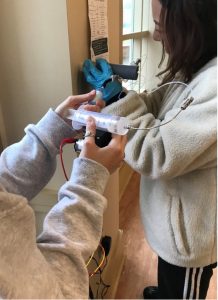Indoor surfaces can play a large role in the chemistry that occurs indoors due to the high surface area to volume ratio in our homes, offices, schools, etc. We know that indoor surfaces can become coated with an organic layer (an “indoor grime”) but we mostly understand the semi-volatile components of these films, not the lower volatility material that can remain on the surface for very long periods of time. Understanding the composition of this material is important because it can form a base layer for partitioning of semi-volatile organics and it can serve as a location for chemical reactions. In our preliminary studies, we have found that there is a large amount of this lower volatility organic material that we can collect with aqueous or organic solvents. We have also found that the viscosity of this film evolves as it ages, pointing to a need for studies of indoor film aging. These studies targeted a few types of surfaces in homes, but wider questions remain about the composition and thickness of these films in other indoor spaces.

The proposed research seeks to characterize and quantify these indoor surface films across a wide range of indoor spaces using an indoor surface solvent extractor that is being developed in our lab.
The proposed project will provide a novel solvent extraction mechanism for indoor surfaces that can be widely used in the community. We will also provide insights into the composition of indoor surface films in test homes/rooms and during planned field campaigns. Finally, we will link the surface measurements to measurements in the gas-phase by comparing with co-located instruments as well as size-resolved aerosol collections.
The specific aims of this proposal are to:
- Collect a wider range of surface film extracts to characterize the distribution of chemicals in the extractable material.
- Quantify the film thickness using offline-AMS and organic molecules representative of those identified in the films.
- Compare the composition of the films to aerosol particles across a wide size range using impactors similar solvent extraction methods.
This work will be carried out at William & Mary and at the CASA field campaign.